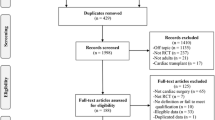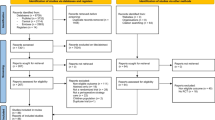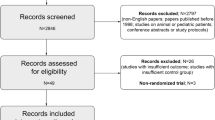Abstract
Post-cardiac surgery acute kidney injury (AKI) is common and is associated with a significant increase in morbidity and mortality. We aimed to systematically review randomised trials that assessed the renoprotective utility of pharmacological agents in patients undergoing cardiac surgery. We searched PubMed, Embase and the Cochrane Central Register of Controlled Trials for randomised controlled trials comparing renoprotective pharmacological interventions with control in adult patients undergoing cardiac surgery with cardiopulmonary bypass. We extracted data for mortality, need for renal replacement therapy (RRT), incidence of AKI, and creatinine clearance at 24–48 h. About 49 randomised controlled trials involving 4605 patients were included. Pharmacological interventions included dopamine, fenoldopam, calcium channel antagonists, natriuretic peptides, diuretics, and N-acetylcysteine. Most trials were of poor quality, with small sample sizes, under-reporting of randomisation procedure, allocation concealment and method of blinding. No pharmacological intervention significantly reduced mortality. Fenoldopam and Atrial Natriuretic Peptide (ANP) reduced the need for renal replacement therapy by 5% (NNT 20, 95% CI 11.3, 83.0) and 3.5% (NNT 29, 95% CI 17.1, 84.4), respectively. Brain Natriuretic Peptide resulted in a 10% reduction in the incidence of AKI (NNT 11, 95% CI 6.2, 32.0). Dopamine caused a significant reduction in creatinine clearance (−4.26 ml/min, 95% CI −7.14, −1.39). The quality of studies that have assessed pharmacological renoprotective agents in cardiac surgery is generally poor. Fenoldopam, ANP and BNP show evidence of renoprotection. Randomised studies evaluating the effect of novel renoprotective agents that are powered to detect clinically relevant differences in outcomes are required.






Similar content being viewed by others
References
Bellomo R, Ronco C, Kellum JA et al (2004) Acute renal failure—definition, outcome measures, animal models, fluid therapy and information technology needs: the second international consensus conference of the Acute Dialysis Quality Initiative (ADQI) Group. Crit Care 8:R204–R212
Rosner MH, Okusa MD (2006) Acute kidney injury associated with cardiac surgery. Clin J Am Soc Nephrol 1:19–32
Karkouti K, Wijeysundera DN, Yau TM et al (2009) Acute kidney injury after cardiac surgery: focus on modifiable risk factors. Circulation 119:495–502
Mangano CM, Diamondstone LS, Ramsay JG et al (1998) Renal dysfunction after myocardial revascularization: risk factors, adverse outcomes, and hospital resource utilization. The Multicenter Study of Perioperative Ischemia Research Group. Ann Intern Med 128:194–203
Thakar CV, Worley S, Arrigain S et al (2005) Influence of renal dysfunction on mortality after cardiac surgery: modifying effect of preoperative renal function. Kidney Int 67:1112–1119
Thakar CV, Worley S, Arrigain S et al (2007) Improved survival in acute kidney injury after cardiac surgery. Am J Kidney Dis 50:703–711
Jadad AR, Moore RA, Carroll D et al (1996) Assessing the quality of reports of randomized clinical trials: is blinding necessary? Control Clin Trials 17:1–12
Higgins JPT (2008) GSe. Cochrane handbook for systematic reviews of interventions version 5.0.1 [updated September 2008]. The Cochrane Collaboration, Oxford
Moher D, Cook DJ, Eastwood S et al (1999) Improving the quality of reports of meta-analyses of randomised controlled trials: the QUOROM statement. Quality of reporting of meta-analyses. Lancet 354:1896–1900
Friedrich JO, Adhikari NK, Beyene J (2007) Inclusion of zero total event trials in meta-analyses maintains analytic consistency and incorporates all available data. BMC Med Res Methodol 7:5
Ranucci M, Soro G, Barzaghi N et al (2004) Fenoldopam prophylaxis of postoperative acute renal failure in high-risk cardiac surgery patients. Ann Thorac Surg 78:1332–1337
Morariu AM, Loef BG, Aarts LP et al (2005) Dexamethasone: benefit and prejudice for patients undergoing on-pump coronary artery bypass grafting: a study on myocardial, pulmonary, renal, intestinal, and hepatic injury. Chest 128:2677–2687
Haase M, Haase-Fielitz A, Ratnaike S et al (2008) N-acetylcysteine does not artifactually lower plasma creatinine concentration. Nephrol Dial Transplant 23:1581–1587
Gatot I, Abramov D, Tsodikov V et al (2004) Should we give prophylactic renal-dose dopamine after coronary artery bypass surgery? J Card Surg 19:128–133
Carcoana OV, Mathew JP, Davis E et al (2003) Mannitol and dopamine in patients undergoing cardiopulmonary bypass: a randomized clinical trial. Anesth Analg 97:1222–1229
Woo EB, Tang AT, el-Gamel A et al (2002) Dopamine therapy for patients at risk of renal dysfunction following cardiac surgery: science or fiction? Eur J Cardiothorac Surg 22:106–111
Yavuz S, Ayabakan N, Goncu MT et al (2002) Effect of combined dopamine and diltiazem on renal function after cardiac surgery. Med Sci Monit 8:PI45–PI50
Yavuz S, Ayabakan N, Dilek K et al (2002) Renal dose dopamine in open heart surgery. Does it protect renal tubular function? J Cardiovasc Surg (Torino) 43:25–30
Sumeray M, Robertson C, Lapsley M et al (2001) Low dose dopamine infusion reduces renal tubular injury following cardiopulmonary bypass surgery. J Nephrol 14:397–402
Lassnigg A, Donner E, Grubhofer G et al (2000) Lack of renoprotective effects of dopamine and furosemide during cardiac surgery. J Am Soc Nephrol 11:97–104
Tang AT, El-Gamel A, Keevil B et al (1999) The effect of ‘renal-dose’ dopamine on renal tubular function following cardiac surgery: assessed by measuring retinol binding protein (RBP). Eur J Cardiothorac Surg 15:717–721
Lema G, Urzua J, Jalil R et al (1998) Renal protection in patients undergoing cardiopulmonary bypass with preoperative abnormal renal function. Anesth Analg 86:3–8
Myles PS, Buckland MR, Schenk NJ et al (1993) Effect of “renal-dose” dopamine on renal function following cardiac surgery. Anaesth Intensive Care 21:56–61
Costa P, Ottino GM, Matani A et al (1990) Low-dose dopamine during cardiopulmonary bypass in patients with renal dysfunction. J Cardiothorac Anesth 4:469–473
Cogliati AA, Vellutini R, Nardini A et al (2007) Fenoldopam infusion for renal protection in high-risk cardiac surgery patients: a randomized clinical study. J Cardiothorac Vasc Anesth 21:847–850
Bove T, Landoni G, Calabro MG et al (2005) Renoprotective action of fenoldopam in high-risk patients undergoing cardiac surgery: a prospective, double-blind, randomized clinical trial. Circulation 111:3230–3235
Caimmi PP, Pagani L, Micalizzi E et al (2003) Fenoldopam for renal protection in patients undergoing cardiopulmonary bypass. J Cardiothorac Vasc Anesth 17:491–494
Halpenny M, Lakshmi S, O’Donnell A et al (2001) Fenoldopam: renal and splanchnic effects in patients undergoing coronary artery bypass grafting. Anaesthesia 56:953–960
Piper SN, Kumle B, Maleck WH et al (2003) Diltiazem may preserve renal tubular integrity after cardiac surgery. Can J Anaesth 50:285–292
Bergman AS, Odar-Cederlof I, Westman L et al (2002) Diltiazem infusion for renal protection in cardiac surgical patients with preexisting renal dysfunction. J Cardiothorac Vasc Anesth 16:294–299
Amano J, Suzuki A, Sunamori M et al (1995) Effect of calcium antagonist diltiazem on renal function in open heart surgery. Chest 107:1260–1265
Witczak BJ, Hartmann A, Geiran OR et al (2008) Renal function after cardiopulmonary bypass surgery in patients with impaired renal function. A randomized study of the effect of nifedipine. Eur J Anaesthesiol 25:319–325
Bertolissi M, Antonucci F, De Monte A et al (1996) Effects on renal function of a continuous infusion of nifedipine during cardiopulmonary bypass. J Cardiothorac Vasc Anesth 10:238–242
Sezai A, Hata M, Niino T et al (2009) Influence of continuous infusion of low-dose human atrial natriuretic peptide on renal function during cardiac surgery: a randomized controlled study. J Am Coll Cardiol 54:1058–1064
Izumi K, Eishi K, Yamachika S et al (2008) The efficacy of human atrial natriuretic peptide in patients with renal dysfunction undergoing cardiac surgery. Ann Thorac Cardiovasc Surg 14:294–302
Sezai A, Hata M, Wakui S et al (2007) Efficacy of continuous low-dose hANP administration in patients undergoing emergent coronary artery bypass grafting for acute coronary syndrome. Circ J 71:1401–1407
Sezai A, Hata M, Wakui S et al (2006) Efficacy of low-dose continuous infusion of alpha-human atrial natriuretic peptide (hANP) during cardiac surgery: possibility of postoperative left ventricular remodeling effect. Circ J 70:1426–1431
Sward K, Valsson F, Odencrants P et al (2004) Recombinant human atrial natriuretic peptide in ischemic acute renal failure: a randomized placebo-controlled trial. Crit Care Med 32:1310–1315
Sezai A, Shiono M, Orime Y et al (2000) Low-dose continuous infusion of human atrial natriuretic peptide during and after cardiac surgery. Ann Thorac Surg 69:732–738
Hayashida N, Chihara S, Kashikie H et al (2000) Effects of intraoperative administration of atrial natriuretic peptide. Ann Thorac Surg 70:1319–1326
Bergman A, Odar-Cederlof I, Westman L et al (1996) Effects of human atrial natriuretic peptide in patients after coronary artery bypass surgery. J Cardiothorac Vasc Anesth 10:490–496
Ejaz AA, Martin TD, Johnson RJ et al (2009) Prophylactic nesiritide does not prevent dialysis or all-cause mortality in patients undergoing high-risk cardiac surgery. J Thorac Cardiovasc Surg 138:959–964
Chen HH, Sundt TM, Cook DJ et al (2007) Low dose nesiritide and the preservation of renal function in patients with renal dysfunction undergoing cardiopulmonary-bypass surgery: a double-blind placebo-controlled pilot study. Circulation 116:I134–I138
Mentzer RM Jr, Oz MC, Sladen RN et al (2007) Effects of perioperative nesiritide in patients with left ventricular dysfunction undergoing cardiac surgery:the NAPA trial. J Am Coll Cardiol 49:716–726
Kaya K, Oguz M, Akar AR et al (2007) The effect of sodium nitroprusside infusion on renal function during reperfusion period in patients undergoing coronary artery bypass grafting: a prospective randomized clinical trial. Eur J Cardiothorac Surg 31:290–297
Boldt J, Brosch C, Lehmann A et al (2004) The prophylactic use of the beta-blocker esmolol in combination with phosphodiesterase III inhibitor enoximone in elderly cardiac surgery patients. Anesth Analg 99:1009–1017
Boldt J, Brosch C, Suttner S et al (2002) Prophylactic use of the phospodiesterase III inhibitor enoximone in elderly cardiac surgery patients: effect on hemodynamics, inflammation, and markers of organ function. Intensive Care Med 28:1462–1469
Abe K, Fujino Y, Sakakibara T (1993) The effect of prostaglandin E1 during cardiopulmonary bypass on renal function after cardiac surgery. Eur J Clin Pharmacol 45:217–220
Morgera S, Woydt R, Kern H et al (2002) Low-dose prostacyclin preserves renal function in high-risk patients after coronary bypass surgery. Crit Care Med 30:107–112
Mahesh B, Yim B, Robson D et al (2008) Does furosemide prevent renal dysfunction in high-risk cardiac surgical patients? Results of a double-blinded prospective randomised trial. Eur J Cardiothorac Surg 33:370–376
Smith MN, Best D, Sheppard SV et al (2008) The effect of mannitol on renal function after cardiopulmonary bypass in patients with established renal dysfunction. Anaesthesia 63:701–704
Yallop KG, Sheppard SV, Smith DC (2008) The effect of mannitol on renal function following cardio-pulmonary bypass in patients with normal pre-operative creatinine. Anaesthesia 63:576–582
Adabag AS, Ishani A, Koneswaran S et al (2008) Utility of N-acetylcysteine to prevent acute kidney injury after cardiac surgery: a randomized controlled trial. Am Heart J 155:1143–1149
Sisillo E, Ceriani R, Bortone F et al (2008) N-acetylcysteine for prevention of acute renal failure in patients with chronic renal insufficiency undergoing cardiac surgery: a prospective, randomized, clinical trial. Crit Care Med 36:81–86
Wijeysundera DN, Beattie WS, Rao V et al (2007) N-acetylcysteine for preventing acute kidney injury in cardiac surgery patients with pre-existing moderate renal insufficiency. Can J Anaesth 54:872–881
Haase M, Haase-Fielitz A, Bagshaw SM et al (2007) Phase II, randomized, controlled trial of high-dose N-acetylcysteine in high-risk cardiac surgery patients. Crit Care Med 35:1324–1331
Ristikankare A, Kuitunen T, Kuitunen A et al (2006) Lack of renoprotective effect of i.v. N-acetylcysteine in patients with chronic renal failure undergoing cardiac surgery. Br J Anaesth 97:611–616
Burns KE, Chu MW, Novick RJ et al (2005) Perioperative N-acetylcysteine to prevent renal dysfunction in high-risk patients undergoing cabg surgery: a randomized controlled trial. JAMA 294:342–350
Barr LF, Kolodner K (2008) N-acetylcysteine and fenoldopam protect the renal function of patients with chronic renal insufficiency undergoing cardiac surgery. Crit Care Med 36:1427–1435
El-Hamamsy I, Stevens LM, Carrier M et al (2007) Effect of intravenous N-acetylcysteine on outcomes after coronary artery bypass surgery: a randomized, double-blind, placebo-controlled clinical trial. J Thorac Cardiovasc Surg 133:7–12
Loef BG, Henning RH, Epema AH et al (2004) Effect of dexamethasone on perioperative renal function impairment during cardiac surgery with cardiopulmonary bypass. Br J Anaesth 93:793–798
McBride WT, Allen S, Gormley SM et al (2004) Methylprednisolone favourably alters plasma and urinary cytokine homeostasis and subclinical renal injury at cardiac surgery. Cytokine 27:81–89
Zacharias M, Gilmore IC, Herbison GP et al. (2005) Interventions for protecting renal function in the perioperative period. Cochrane Database Syst Rev: CD003590
Friedrich JO, Adhikari N, Herridge MS et al (2005) Meta-analysis: low-dose dopamine increases urine output but does not prevent renal dysfunction or death. Ann Intern Med 142:510–524
Landoni G, Biondi-Zoccai GG, Marino G et al (2008) Fenoldopam reduces the need for renal replacement therapy and in-hospital death in cardiovascular surgery: a meta-analysis. J Cardiothorac Vasc Anesth 22:27–33
Landoni G, Biondi-Zoccai GG, Tumlin JA et al (2007) Beneficial impact of fenoldopam in critically ill patients with or at risk for acute renal failure: a meta-analysis of randomized clinical trials. Am J Kidney Dis 49:56–68
Nigwekar SU, Navaneethan SD, Parikh CR et al (2008) Atrial natriuretic peptide for management of acute kidney injury: a systematic review and meta-analysis. Clin J Am Soc Nephrol 4(2):261–272
Chintala MS, Chiu PJ, Vemulapalli S et al (1993) Inhibition of endothelial derived relaxing factor (EDRF) aggravates ischemic acute renal failure in anesthetized rats. Naunyn Schmiedebergs Arch Pharmacol 348:305–310
Kurata H, Takaoka M, Kubo Y et al (2004) Nitric oxide protects against ischemic acute renal failure through the suppression of renal endothelin-1 overproduction. J Cardiovasc Pharmacol 44:S455–S458
Matsumura Y, Nishiura M, Deguchi S et al (1998) Protective effect of FK409, a spontaneous nitric oxide releaser, on ischemic acute renal failure in rats. J Pharmacol Exp Ther 287:1084–1091
Goligorsky MS, Brodsky SV, Noiri E (2002) Nitric oxide in acute renal failure: NOS versus NOS. Kidney Int 61:855–861
Baker WL, Anglade MW, Baker EL et al (2009) Use of N-acetylcysteine to reduce post-cardiothoracic surgery complications: a meta-analysis. Eur J Cardiothorac Surg 35:521–527
Naughton F, Wijeysundera D, Karkouti K et al (2008) N-acetylcysteine to reduce renal failure after cardiac surgery: a systematic review and meta-analysis. Can J Anaesth 55:827–835
Nigwekar SU, Kandula P (2009) N-acetylcysteine in cardiovascular-surgery-associated renal failure: a meta-analysis. Ann Thorac Surg 87:139–147
Ho KM, Morgan DJ (2009) Meta-analysis of N-acetylcysteine to prevent acute renal failure after major surgery. Am J Kidney Dis 53:33–40
Zhu J, Yin R, Shao H et al (2007) N-acetylcysteine to ameliorate acute renal injury in a rat cardiopulmonary bypass model. J Thorac Cardiovasc Surg 133:696–703
DiMari J, Megyesi J, Udvarhelyi N et al (1997) N-acetyl cysteine ameliorates ischemic renal failure. Am J Physiol 272:F292–F298
Decramer M, Rutten-van Molken M, Dekhuijzen PN et al (2005) Effects of N-acetylcysteine on outcomes in chronic obstructive pulmonary disease (Bronchitis Randomized on NAC Cost-Utility study, BRONCUS): a randomised placebo-controlled trial. Lancet 365:1552–1560
van Zandwijk N, Dalesio O, Pastorino U et al (2000) EUROSCAN, a randomized trial of vitamin A and N-acetylcysteine in patients with head and neck cancer or lung cancer. For the EUropean Organization for Research and Treatment of Cancer Head and Neck and Lung Cancer Cooperative Groups. J Natl Cancer Inst 92:977–986
Murphy GJ, Reeves BC, Rogers CA et al (2007) Increased mortality, postoperative morbidity, and cost after red blood cell transfusion in patients having cardiac surgery. Circulation 116:2544–2552
Haase M, Bellomo R, Haase-Fielitz A (2010) Novel biomarkers, oxidative stress, and the role of labile iron toxicity in cardiopulmonary bypass-associated acute kidney injury. J Am Coll Cardiol 55:2024–2033
Acknowledgments
The Royal College of Surgeons of England, British Heart Foundation, Higher Education Funding Council of England are acknowledged.
Conflict of interest
All authors declare that they have no competing interests.
Author information
Authors and Affiliations
Corresponding author
Rights and permissions
About this article
Cite this article
Patel, N.N., Rogers, C.A., Angelini, G.D. et al. Pharmacological therapies for the prevention of acute kidney injury following cardiac surgery: a systematic review. Heart Fail Rev 16, 553–567 (2011). https://doi.org/10.1007/s10741-011-9235-5
Published:
Issue Date:
DOI: https://doi.org/10.1007/s10741-011-9235-5




